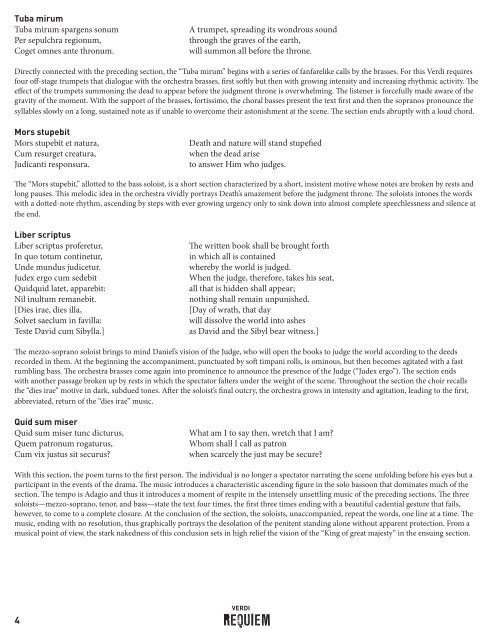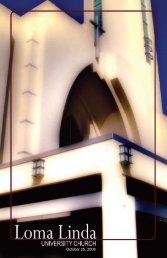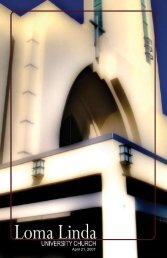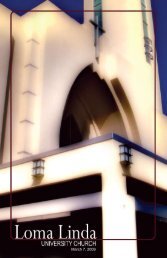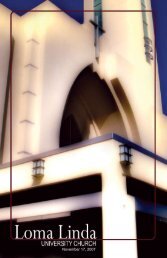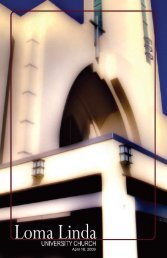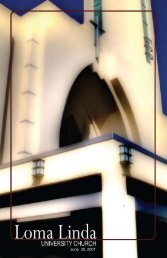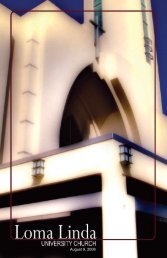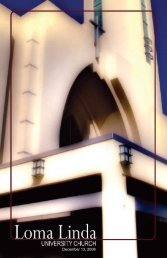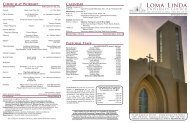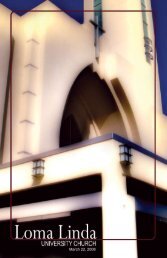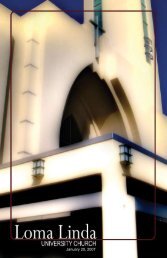LLUC Verdi Requiem Concert Program - Loma Linda University ...
LLUC Verdi Requiem Concert Program - Loma Linda University ...
LLUC Verdi Requiem Concert Program - Loma Linda University ...
- No tags were found...
Create successful ePaper yourself
Turn your PDF publications into a flip-book with our unique Google optimized e-Paper software.
Tuba mirum<br />
Tuba mirum spargens sonum<br />
Per sepulchra regionum,<br />
Coget omnes ante thronum.<br />
A trumpet, spreading its wondrous sound<br />
through the graves of the earth,<br />
will summon all before the throne.<br />
Directly connected with the preceding section, the “Tuba mirum” begins with a series of fanfarelike calls by the brasses. For this <strong>Verdi</strong> requires<br />
four off-stage trumpets that dialogue with the orchestra brasses, first softly but then with growing intensity and increasing rhythmic activity. The<br />
effect of the trumpets summoning the dead to appear before the judgment throne is overwhelming. The listener is forcefully made aware of the<br />
gravity of the moment. With the support of the brasses, fortissimo, the choral basses present the text first and then the sopranos pronounce the<br />
syllables slowly on a long, sustained note as if unable to overcome their astonishment at the scene. The section ends abruptly with a loud chord.<br />
Mors stupebit<br />
Mors stupebit et natura,<br />
Cum resurget creatura,<br />
Judicanti responsura.<br />
Death and nature will stand stupefied<br />
when the dead arise<br />
to answer Him who judges.<br />
The “Mors stupebit,” allotted to the bass soloist, is a short section characterized by a short, insistent motive whose notes are broken by rests and<br />
long pauses. This melodic idea in the orchestra vividly portrays Death’s amazement before the judgment throne. The soloists intones the words<br />
with a dotted-note rhythm, ascending by steps with ever growing urgency only to sink down into almost complete speechlessness and silence at<br />
the end.<br />
Liber scriptus<br />
Liber scriptus proferetur,<br />
In quo totum continetur,<br />
Unde mundus judicetur.<br />
Judex ergo cum sedebit<br />
Quidquid latet, apparebit:<br />
Nil inultum remanebit.<br />
[Dies irae, dies illa,<br />
Solvet saeclum in favilla:<br />
Teste David cum Sibylla.]<br />
The written book shall be brought forth<br />
in which all is contained<br />
whereby the world is judged.<br />
When the judge, therefore, takes his seat,<br />
all that is hidden shall appear;<br />
nothing shall remain unpunished.<br />
[Day of wrath, that day<br />
will dissolve the world into ashes<br />
as David and the Sibyl bear witness.]<br />
The mezzo-soprano soloist brings to mind Daniel’s vision of the Judge, who will open the books to judge the world according to the deeds<br />
recorded in them. At the beginning the accompaniment, punctuated by soft timpani rolls, is ominous, but then becomes agitated with a fast<br />
rumbling bass. The orchestra brasses come again into prominence to announce the presence of the Judge (“Judex ergo”). The section ends<br />
with another passage broken up by rests in which the spectator falters under the weight of the scene. Throughout the section the choir recalls<br />
the “dies irae” motive in dark, subdued tones. After the soloist’s final outcry, the orchestra grows in intensity and agitation, leading to the first,<br />
abbreviated, return of the “dies irae” music.<br />
Quid sum miser<br />
Quid sum miser tunc dicturus,<br />
Quem patronum rogaturus,<br />
Cum vix justus sit securus<br />
What am I to say then, wretch that I am<br />
Whom shall I call as patron<br />
when scarcely the just may be secure<br />
With this section, the poem turns to the first person. The individual is no longer a spectator narrating the scene unfolding before his eyes but a<br />
participant in the events of the drama. The music introduces a characteristic ascending figure in the solo bassoon that dominates much of the<br />
section. The tempo is Adagio and thus it introduces a moment of respite in the intensely unsettling music of the preceding sections. The three<br />
soloists—mezzo-soprano, tenor, and bass—state the text four times, the first three times ending with a beautiful cadential gesture that fails,<br />
however, to come to a complete closure. At the conclusion of the section, the soloists, unaccompanied, repeat the words, one line at a time. The<br />
music, ending with no resolution, thus graphically portrays the desolation of the penitent standing alone without apparent protection. From a<br />
musical point of view, the stark nakedness of this conclusion sets in high relief the vision of the “King of great majesty” in the ensuing section.<br />
4<br />
VERDI<br />
REQUIEM


